Aspects of Entrepreneurial Ventures
VerifiedAdded on 2023/01/12
|14
|4022
|68
AI Summary
This document explores different types of entrepreneurial ventures and their relation to the typology of entrepreneurship. It also discusses the similarities and differences between entrepreneurial ventures, the impact of micro and small businesses on the economy, and the characteristic traits and skills of successful entrepreneurs.
Contribute Materials
Your contribution can guide someone’s learning journey. Share your
documents today.

Aspects of entrepreneurial
ventures
ventures
Secure Best Marks with AI Grader
Need help grading? Try our AI Grader for instant feedback on your assignments.
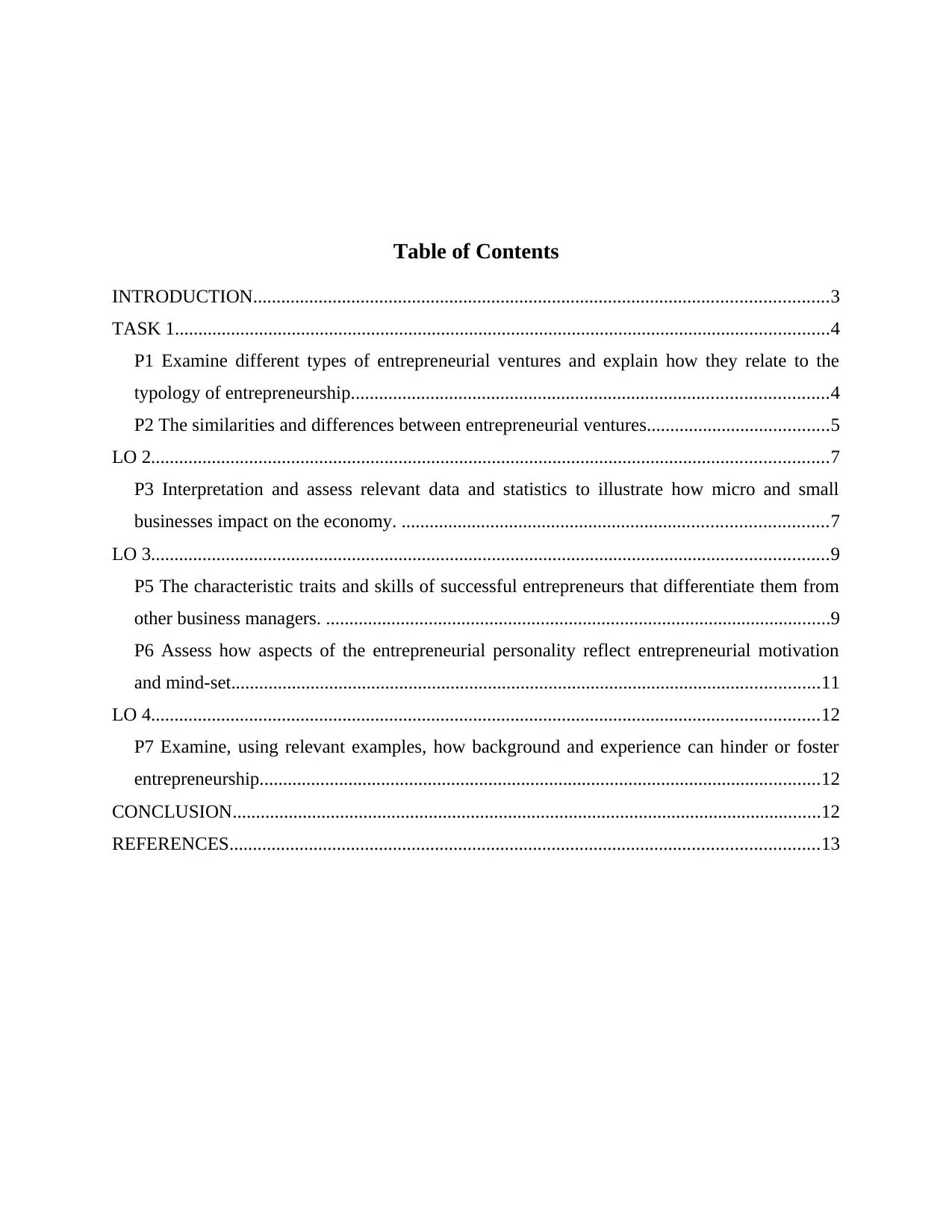
Table of Contents
INTRODUCTION...........................................................................................................................3
TASK 1............................................................................................................................................4
P1 Examine different types of entrepreneurial ventures and explain how they relate to the
typology of entrepreneurship......................................................................................................4
P2 The similarities and differences between entrepreneurial ventures.......................................5
LO 2.................................................................................................................................................7
P3 Interpretation and assess relevant data and statistics to illustrate how micro and small
businesses impact on the economy. ...........................................................................................7
LO 3.................................................................................................................................................9
P5 The characteristic traits and skills of successful entrepreneurs that differentiate them from
other business managers. ............................................................................................................9
P6 Assess how aspects of the entrepreneurial personality reflect entrepreneurial motivation
and mind-set..............................................................................................................................11
LO 4...............................................................................................................................................12
P7 Examine, using relevant examples, how background and experience can hinder or foster
entrepreneurship........................................................................................................................12
CONCLUSION..............................................................................................................................12
REFERENCES..............................................................................................................................13
INTRODUCTION...........................................................................................................................3
TASK 1............................................................................................................................................4
P1 Examine different types of entrepreneurial ventures and explain how they relate to the
typology of entrepreneurship......................................................................................................4
P2 The similarities and differences between entrepreneurial ventures.......................................5
LO 2.................................................................................................................................................7
P3 Interpretation and assess relevant data and statistics to illustrate how micro and small
businesses impact on the economy. ...........................................................................................7
LO 3.................................................................................................................................................9
P5 The characteristic traits and skills of successful entrepreneurs that differentiate them from
other business managers. ............................................................................................................9
P6 Assess how aspects of the entrepreneurial personality reflect entrepreneurial motivation
and mind-set..............................................................................................................................11
LO 4...............................................................................................................................................12
P7 Examine, using relevant examples, how background and experience can hinder or foster
entrepreneurship........................................................................................................................12
CONCLUSION..............................................................................................................................12
REFERENCES..............................................................................................................................13
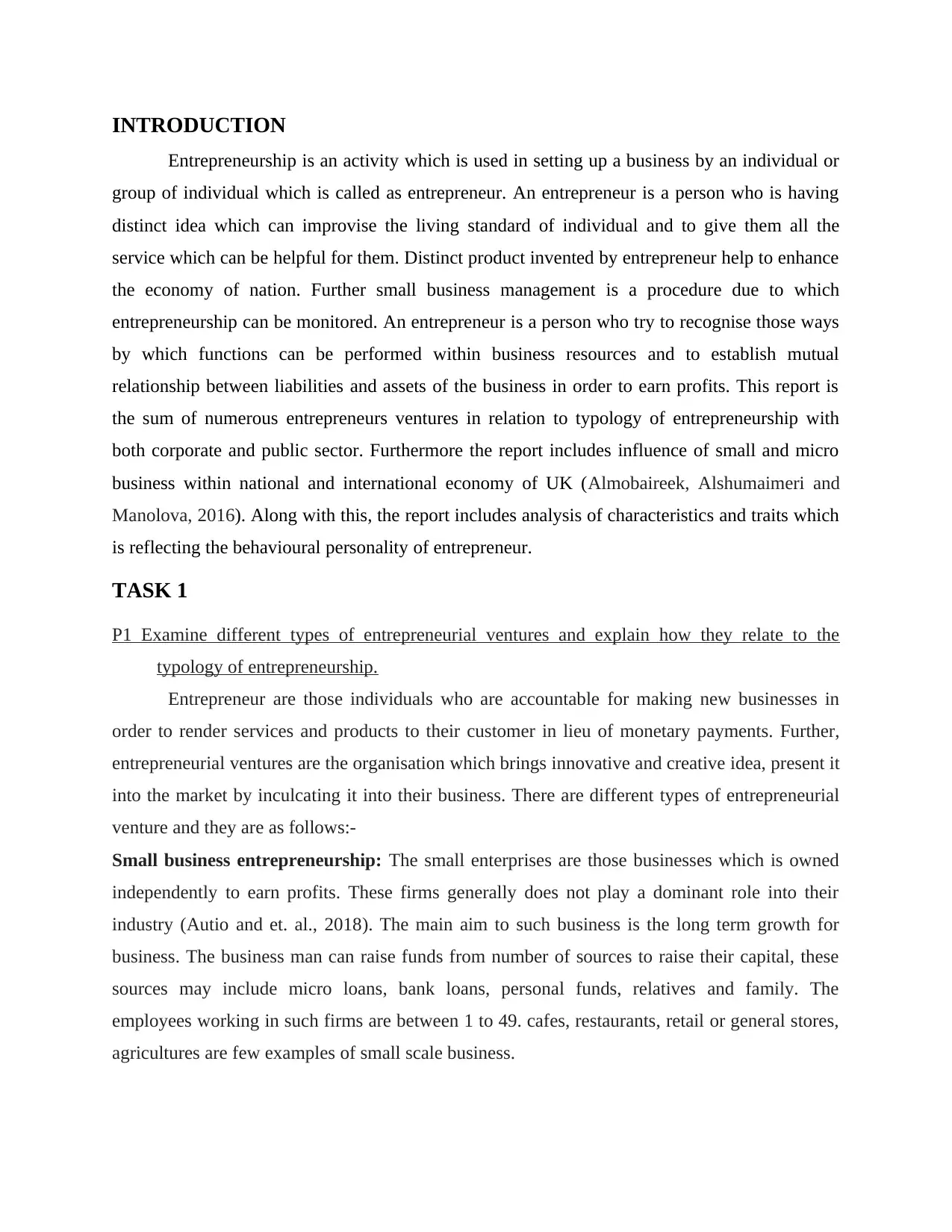
INTRODUCTION
Entrepreneurship is an activity which is used in setting up a business by an individual or
group of individual which is called as entrepreneur. An entrepreneur is a person who is having
distinct idea which can improvise the living standard of individual and to give them all the
service which can be helpful for them. Distinct product invented by entrepreneur help to enhance
the economy of nation. Further small business management is a procedure due to which
entrepreneurship can be monitored. An entrepreneur is a person who try to recognise those ways
by which functions can be performed within business resources and to establish mutual
relationship between liabilities and assets of the business in order to earn profits. This report is
the sum of numerous entrepreneurs ventures in relation to typology of entrepreneurship with
both corporate and public sector. Furthermore the report includes influence of small and micro
business within national and international economy of UK (Almobaireek, Alshumaimeri and
Manolova, 2016). Along with this, the report includes analysis of characteristics and traits which
is reflecting the behavioural personality of entrepreneur.
TASK 1
P1 Examine different types of entrepreneurial ventures and explain how they relate to the
typology of entrepreneurship.
Entrepreneur are those individuals who are accountable for making new businesses in
order to render services and products to their customer in lieu of monetary payments. Further,
entrepreneurial ventures are the organisation which brings innovative and creative idea, present it
into the market by inculcating it into their business. There are different types of entrepreneurial
venture and they are as follows:-
Small business entrepreneurship: The small enterprises are those businesses which is owned
independently to earn profits. These firms generally does not play a dominant role into their
industry (Autio and et. al., 2018). The main aim to such business is the long term growth for
business. The business man can raise funds from number of sources to raise their capital, these
sources may include micro loans, bank loans, personal funds, relatives and family. The
employees working in such firms are between 1 to 49. cafes, restaurants, retail or general stores,
agricultures are few examples of small scale business.
Entrepreneurship is an activity which is used in setting up a business by an individual or
group of individual which is called as entrepreneur. An entrepreneur is a person who is having
distinct idea which can improvise the living standard of individual and to give them all the
service which can be helpful for them. Distinct product invented by entrepreneur help to enhance
the economy of nation. Further small business management is a procedure due to which
entrepreneurship can be monitored. An entrepreneur is a person who try to recognise those ways
by which functions can be performed within business resources and to establish mutual
relationship between liabilities and assets of the business in order to earn profits. This report is
the sum of numerous entrepreneurs ventures in relation to typology of entrepreneurship with
both corporate and public sector. Furthermore the report includes influence of small and micro
business within national and international economy of UK (Almobaireek, Alshumaimeri and
Manolova, 2016). Along with this, the report includes analysis of characteristics and traits which
is reflecting the behavioural personality of entrepreneur.
TASK 1
P1 Examine different types of entrepreneurial ventures and explain how they relate to the
typology of entrepreneurship.
Entrepreneur are those individuals who are accountable for making new businesses in
order to render services and products to their customer in lieu of monetary payments. Further,
entrepreneurial ventures are the organisation which brings innovative and creative idea, present it
into the market by inculcating it into their business. There are different types of entrepreneurial
venture and they are as follows:-
Small business entrepreneurship: The small enterprises are those businesses which is owned
independently to earn profits. These firms generally does not play a dominant role into their
industry (Autio and et. al., 2018). The main aim to such business is the long term growth for
business. The business man can raise funds from number of sources to raise their capital, these
sources may include micro loans, bank loans, personal funds, relatives and family. The
employees working in such firms are between 1 to 49. cafes, restaurants, retail or general stores,
agricultures are few examples of small scale business.
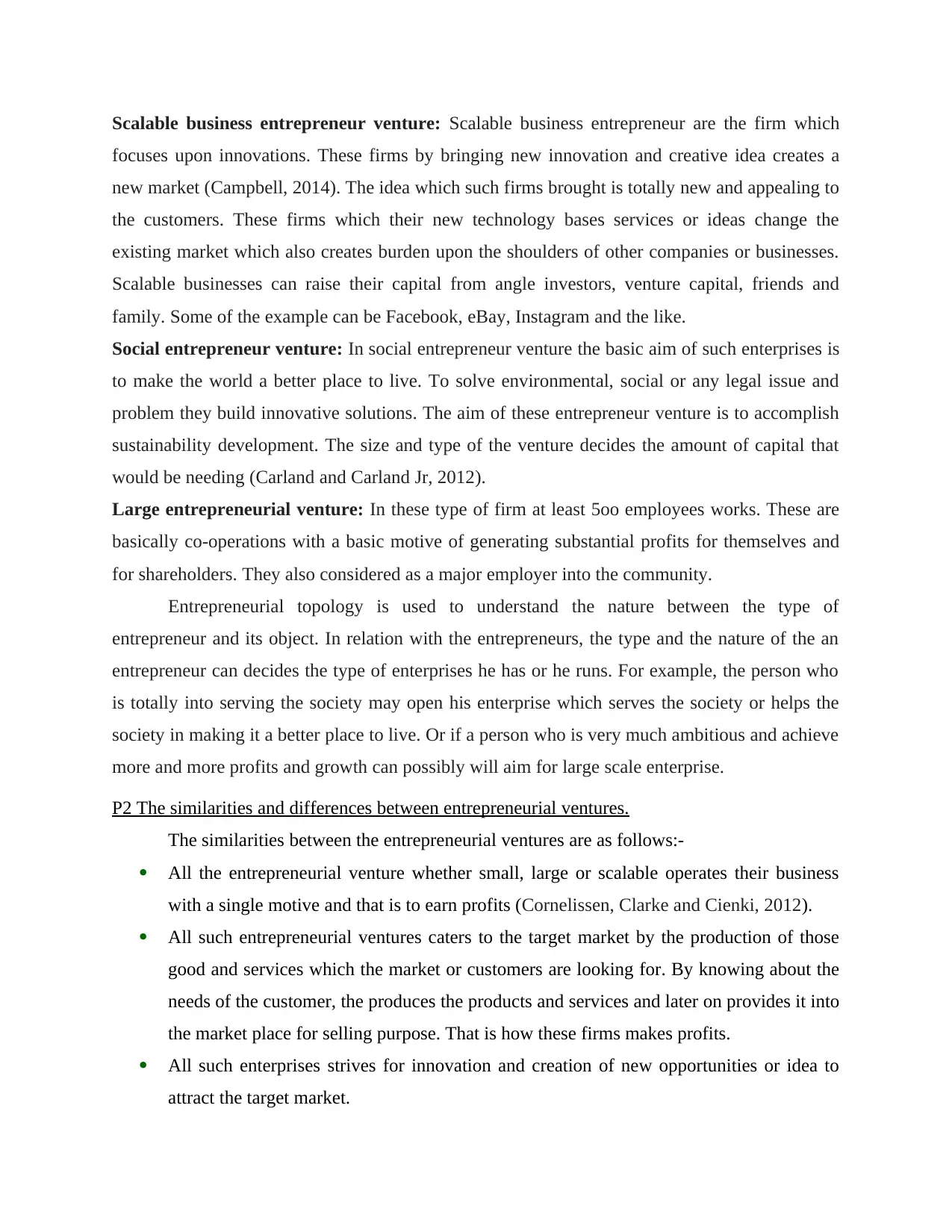
Scalable business entrepreneur venture: Scalable business entrepreneur are the firm which
focuses upon innovations. These firms by bringing new innovation and creative idea creates a
new market (Campbell, 2014). The idea which such firms brought is totally new and appealing to
the customers. These firms which their new technology bases services or ideas change the
existing market which also creates burden upon the shoulders of other companies or businesses.
Scalable businesses can raise their capital from angle investors, venture capital, friends and
family. Some of the example can be Facebook, eBay, Instagram and the like.
Social entrepreneur venture: In social entrepreneur venture the basic aim of such enterprises is
to make the world a better place to live. To solve environmental, social or any legal issue and
problem they build innovative solutions. The aim of these entrepreneur venture is to accomplish
sustainability development. The size and type of the venture decides the amount of capital that
would be needing (Carland and Carland Jr, 2012).
Large entrepreneurial venture: In these type of firm at least 5oo employees works. These are
basically co-operations with a basic motive of generating substantial profits for themselves and
for shareholders. They also considered as a major employer into the community.
Entrepreneurial topology is used to understand the nature between the type of
entrepreneur and its object. In relation with the entrepreneurs, the type and the nature of the an
entrepreneur can decides the type of enterprises he has or he runs. For example, the person who
is totally into serving the society may open his enterprise which serves the society or helps the
society in making it a better place to live. Or if a person who is very much ambitious and achieve
more and more profits and growth can possibly will aim for large scale enterprise.
P2 The similarities and differences between entrepreneurial ventures.
The similarities between the entrepreneurial ventures are as follows:-
All the entrepreneurial venture whether small, large or scalable operates their business
with a single motive and that is to earn profits (Cornelissen, Clarke and Cienki, 2012).
All such entrepreneurial ventures caters to the target market by the production of those
good and services which the market or customers are looking for. By knowing about the
needs of the customer, the produces the products and services and later on provides it into
the market place for selling purpose. That is how these firms makes profits.
All such enterprises strives for innovation and creation of new opportunities or idea to
attract the target market.
focuses upon innovations. These firms by bringing new innovation and creative idea creates a
new market (Campbell, 2014). The idea which such firms brought is totally new and appealing to
the customers. These firms which their new technology bases services or ideas change the
existing market which also creates burden upon the shoulders of other companies or businesses.
Scalable businesses can raise their capital from angle investors, venture capital, friends and
family. Some of the example can be Facebook, eBay, Instagram and the like.
Social entrepreneur venture: In social entrepreneur venture the basic aim of such enterprises is
to make the world a better place to live. To solve environmental, social or any legal issue and
problem they build innovative solutions. The aim of these entrepreneur venture is to accomplish
sustainability development. The size and type of the venture decides the amount of capital that
would be needing (Carland and Carland Jr, 2012).
Large entrepreneurial venture: In these type of firm at least 5oo employees works. These are
basically co-operations with a basic motive of generating substantial profits for themselves and
for shareholders. They also considered as a major employer into the community.
Entrepreneurial topology is used to understand the nature between the type of
entrepreneur and its object. In relation with the entrepreneurs, the type and the nature of the an
entrepreneur can decides the type of enterprises he has or he runs. For example, the person who
is totally into serving the society may open his enterprise which serves the society or helps the
society in making it a better place to live. Or if a person who is very much ambitious and achieve
more and more profits and growth can possibly will aim for large scale enterprise.
P2 The similarities and differences between entrepreneurial ventures.
The similarities between the entrepreneurial ventures are as follows:-
All the entrepreneurial venture whether small, large or scalable operates their business
with a single motive and that is to earn profits (Cornelissen, Clarke and Cienki, 2012).
All such entrepreneurial ventures caters to the target market by the production of those
good and services which the market or customers are looking for. By knowing about the
needs of the customer, the produces the products and services and later on provides it into
the market place for selling purpose. That is how these firms makes profits.
All such enterprises strives for innovation and creation of new opportunities or idea to
attract the target market.
Secure Best Marks with AI Grader
Need help grading? Try our AI Grader for instant feedback on your assignments.
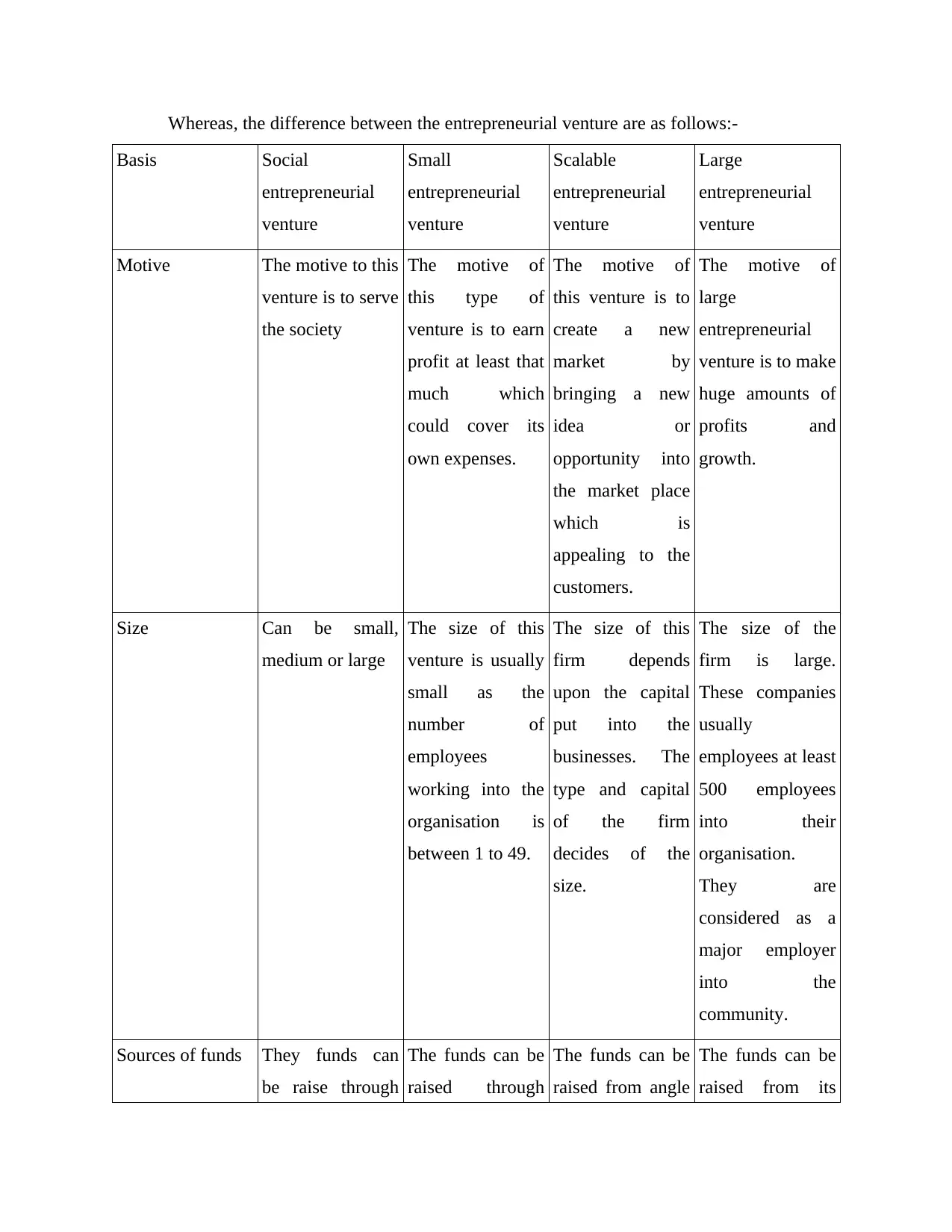
Whereas, the difference between the entrepreneurial venture are as follows:-
Basis Social
entrepreneurial
venture
Small
entrepreneurial
venture
Scalable
entrepreneurial
venture
Large
entrepreneurial
venture
Motive The motive to this
venture is to serve
the society
The motive of
this type of
venture is to earn
profit at least that
much which
could cover its
own expenses.
The motive of
this venture is to
create a new
market by
bringing a new
idea or
opportunity into
the market place
which is
appealing to the
customers.
The motive of
large
entrepreneurial
venture is to make
huge amounts of
profits and
growth.
Size Can be small,
medium or large
The size of this
venture is usually
small as the
number of
employees
working into the
organisation is
between 1 to 49.
The size of this
firm depends
upon the capital
put into the
businesses. The
type and capital
of the firm
decides of the
size.
The size of the
firm is large.
These companies
usually
employees at least
500 employees
into their
organisation.
They are
considered as a
major employer
into the
community.
Sources of funds They funds can
be raise through
The funds can be
raised through
The funds can be
raised from angle
The funds can be
raised from its
Basis Social
entrepreneurial
venture
Small
entrepreneurial
venture
Scalable
entrepreneurial
venture
Large
entrepreneurial
venture
Motive The motive to this
venture is to serve
the society
The motive of
this type of
venture is to earn
profit at least that
much which
could cover its
own expenses.
The motive of
this venture is to
create a new
market by
bringing a new
idea or
opportunity into
the market place
which is
appealing to the
customers.
The motive of
large
entrepreneurial
venture is to make
huge amounts of
profits and
growth.
Size Can be small,
medium or large
The size of this
venture is usually
small as the
number of
employees
working into the
organisation is
between 1 to 49.
The size of this
firm depends
upon the capital
put into the
businesses. The
type and capital
of the firm
decides of the
size.
The size of the
firm is large.
These companies
usually
employees at least
500 employees
into their
organisation.
They are
considered as a
major employer
into the
community.
Sources of funds They funds can
be raise through
The funds can be
raised through
The funds can be
raised from angle
The funds can be
raised from its
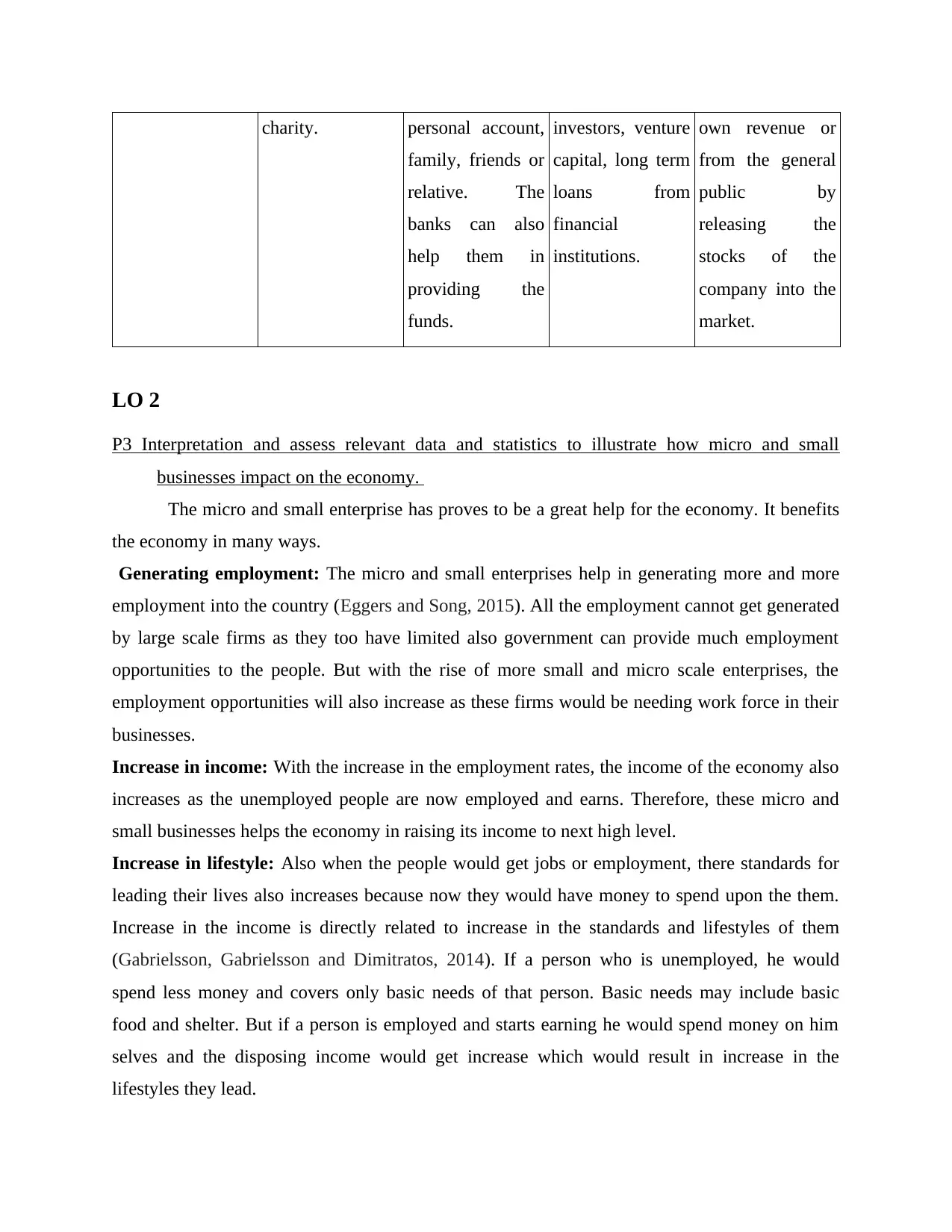
charity. personal account,
family, friends or
relative. The
banks can also
help them in
providing the
funds.
investors, venture
capital, long term
loans from
financial
institutions.
own revenue or
from the general
public by
releasing the
stocks of the
company into the
market.
LO 2
P3 Interpretation and assess relevant data and statistics to illustrate how micro and small
businesses impact on the economy.
The micro and small enterprise has proves to be a great help for the economy. It benefits
the economy in many ways.
Generating employment: The micro and small enterprises help in generating more and more
employment into the country (Eggers and Song, 2015). All the employment cannot get generated
by large scale firms as they too have limited also government can provide much employment
opportunities to the people. But with the rise of more small and micro scale enterprises, the
employment opportunities will also increase as these firms would be needing work force in their
businesses.
Increase in income: With the increase in the employment rates, the income of the economy also
increases as the unemployed people are now employed and earns. Therefore, these micro and
small businesses helps the economy in raising its income to next high level.
Increase in lifestyle: Also when the people would get jobs or employment, there standards for
leading their lives also increases because now they would have money to spend upon the them.
Increase in the income is directly related to increase in the standards and lifestyles of them
(Gabrielsson, Gabrielsson and Dimitratos, 2014). If a person who is unemployed, he would
spend less money and covers only basic needs of that person. Basic needs may include basic
food and shelter. But if a person is employed and starts earning he would spend money on him
selves and the disposing income would get increase which would result in increase in the
lifestyles they lead.
family, friends or
relative. The
banks can also
help them in
providing the
funds.
investors, venture
capital, long term
loans from
financial
institutions.
own revenue or
from the general
public by
releasing the
stocks of the
company into the
market.
LO 2
P3 Interpretation and assess relevant data and statistics to illustrate how micro and small
businesses impact on the economy.
The micro and small enterprise has proves to be a great help for the economy. It benefits
the economy in many ways.
Generating employment: The micro and small enterprises help in generating more and more
employment into the country (Eggers and Song, 2015). All the employment cannot get generated
by large scale firms as they too have limited also government can provide much employment
opportunities to the people. But with the rise of more small and micro scale enterprises, the
employment opportunities will also increase as these firms would be needing work force in their
businesses.
Increase in income: With the increase in the employment rates, the income of the economy also
increases as the unemployed people are now employed and earns. Therefore, these micro and
small businesses helps the economy in raising its income to next high level.
Increase in lifestyle: Also when the people would get jobs or employment, there standards for
leading their lives also increases because now they would have money to spend upon the them.
Increase in the income is directly related to increase in the standards and lifestyles of them
(Gabrielsson, Gabrielsson and Dimitratos, 2014). If a person who is unemployed, he would
spend less money and covers only basic needs of that person. Basic needs may include basic
food and shelter. But if a person is employed and starts earning he would spend money on him
selves and the disposing income would get increase which would result in increase in the
lifestyles they lead.
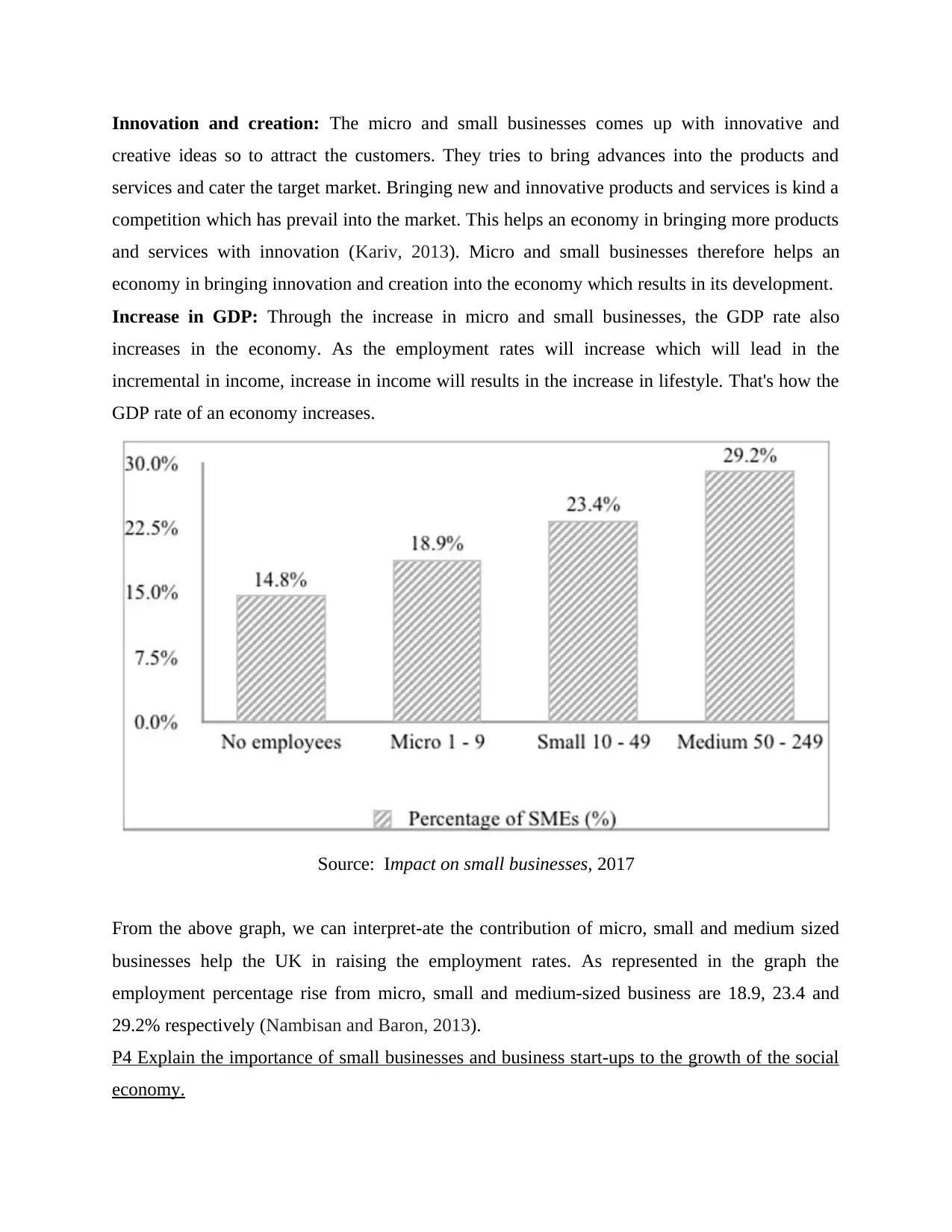
Innovation and creation: The micro and small businesses comes up with innovative and
creative ideas so to attract the customers. They tries to bring advances into the products and
services and cater the target market. Bringing new and innovative products and services is kind a
competition which has prevail into the market. This helps an economy in bringing more products
and services with innovation (Kariv, 2013). Micro and small businesses therefore helps an
economy in bringing innovation and creation into the economy which results in its development.
Increase in GDP: Through the increase in micro and small businesses, the GDP rate also
increases in the economy. As the employment rates will increase which will lead in the
incremental in income, increase in income will results in the increase in lifestyle. That's how the
GDP rate of an economy increases.
Source: Impact on small businesses, 2017
From the above graph, we can interpret-ate the contribution of micro, small and medium sized
businesses help the UK in raising the employment rates. As represented in the graph the
employment percentage rise from micro, small and medium-sized business are 18.9, 23.4 and
29.2% respectively (Nambisan and Baron, 2013).
P4 Explain the importance of small businesses and business start-ups to the growth of the social
economy.
creative ideas so to attract the customers. They tries to bring advances into the products and
services and cater the target market. Bringing new and innovative products and services is kind a
competition which has prevail into the market. This helps an economy in bringing more products
and services with innovation (Kariv, 2013). Micro and small businesses therefore helps an
economy in bringing innovation and creation into the economy which results in its development.
Increase in GDP: Through the increase in micro and small businesses, the GDP rate also
increases in the economy. As the employment rates will increase which will lead in the
incremental in income, increase in income will results in the increase in lifestyle. That's how the
GDP rate of an economy increases.
Source: Impact on small businesses, 2017
From the above graph, we can interpret-ate the contribution of micro, small and medium sized
businesses help the UK in raising the employment rates. As represented in the graph the
employment percentage rise from micro, small and medium-sized business are 18.9, 23.4 and
29.2% respectively (Nambisan and Baron, 2013).
P4 Explain the importance of small businesses and business start-ups to the growth of the social
economy.
Paraphrase This Document
Need a fresh take? Get an instant paraphrase of this document with our AI Paraphraser
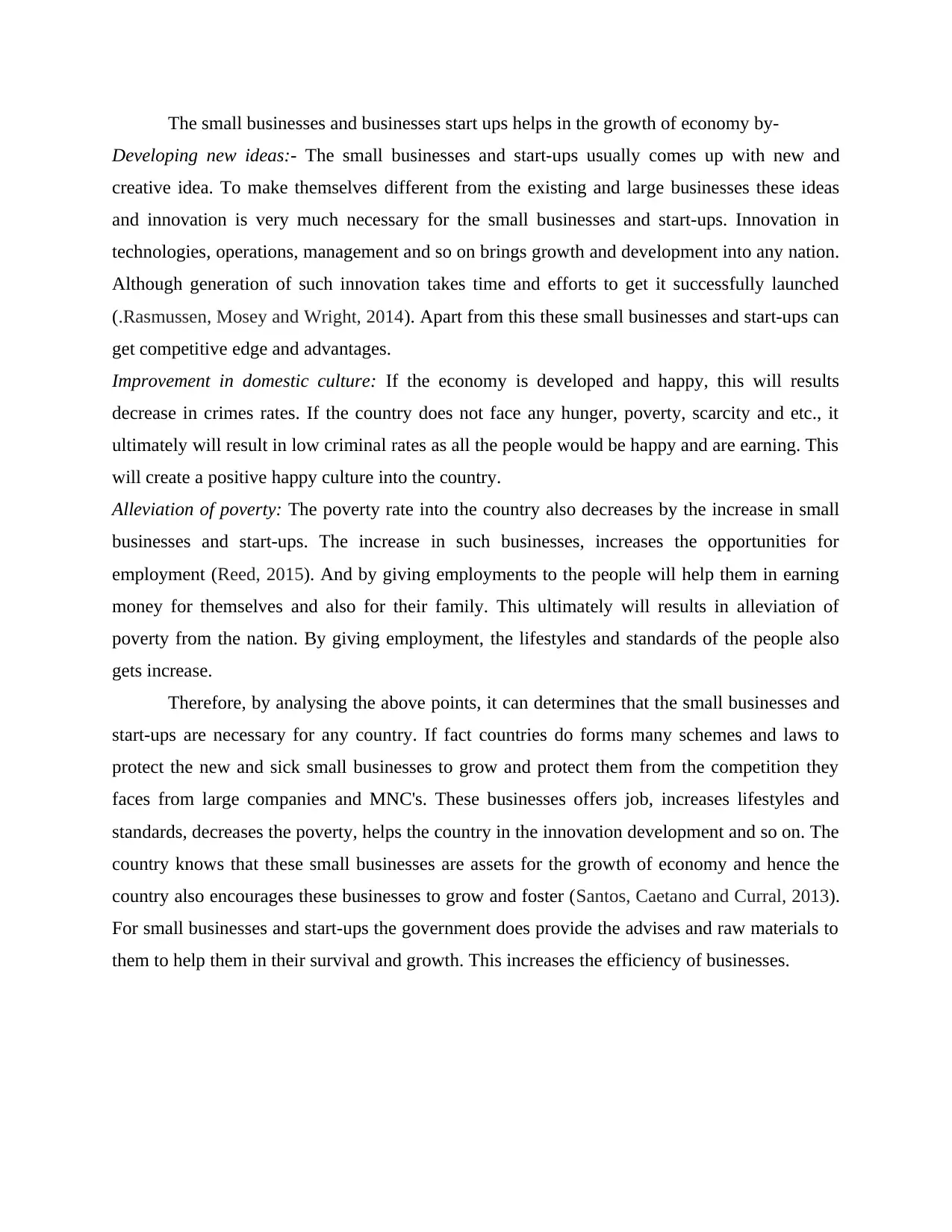
The small businesses and businesses start ups helps in the growth of economy by-
Developing new ideas:- The small businesses and start-ups usually comes up with new and
creative idea. To make themselves different from the existing and large businesses these ideas
and innovation is very much necessary for the small businesses and start-ups. Innovation in
technologies, operations, management and so on brings growth and development into any nation.
Although generation of such innovation takes time and efforts to get it successfully launched
(.Rasmussen, Mosey and Wright, 2014). Apart from this these small businesses and start-ups can
get competitive edge and advantages.
Improvement in domestic culture: If the economy is developed and happy, this will results
decrease in crimes rates. If the country does not face any hunger, poverty, scarcity and etc., it
ultimately will result in low criminal rates as all the people would be happy and are earning. This
will create a positive happy culture into the country.
Alleviation of poverty: The poverty rate into the country also decreases by the increase in small
businesses and start-ups. The increase in such businesses, increases the opportunities for
employment (Reed, 2015). And by giving employments to the people will help them in earning
money for themselves and also for their family. This ultimately will results in alleviation of
poverty from the nation. By giving employment, the lifestyles and standards of the people also
gets increase.
Therefore, by analysing the above points, it can determines that the small businesses and
start-ups are necessary for any country. If fact countries do forms many schemes and laws to
protect the new and sick small businesses to grow and protect them from the competition they
faces from large companies and MNC's. These businesses offers job, increases lifestyles and
standards, decreases the poverty, helps the country in the innovation development and so on. The
country knows that these small businesses are assets for the growth of economy and hence the
country also encourages these businesses to grow and foster (Santos, Caetano and Curral, 2013).
For small businesses and start-ups the government does provide the advises and raw materials to
them to help them in their survival and growth. This increases the efficiency of businesses.
Developing new ideas:- The small businesses and start-ups usually comes up with new and
creative idea. To make themselves different from the existing and large businesses these ideas
and innovation is very much necessary for the small businesses and start-ups. Innovation in
technologies, operations, management and so on brings growth and development into any nation.
Although generation of such innovation takes time and efforts to get it successfully launched
(.Rasmussen, Mosey and Wright, 2014). Apart from this these small businesses and start-ups can
get competitive edge and advantages.
Improvement in domestic culture: If the economy is developed and happy, this will results
decrease in crimes rates. If the country does not face any hunger, poverty, scarcity and etc., it
ultimately will result in low criminal rates as all the people would be happy and are earning. This
will create a positive happy culture into the country.
Alleviation of poverty: The poverty rate into the country also decreases by the increase in small
businesses and start-ups. The increase in such businesses, increases the opportunities for
employment (Reed, 2015). And by giving employments to the people will help them in earning
money for themselves and also for their family. This ultimately will results in alleviation of
poverty from the nation. By giving employment, the lifestyles and standards of the people also
gets increase.
Therefore, by analysing the above points, it can determines that the small businesses and
start-ups are necessary for any country. If fact countries do forms many schemes and laws to
protect the new and sick small businesses to grow and protect them from the competition they
faces from large companies and MNC's. These businesses offers job, increases lifestyles and
standards, decreases the poverty, helps the country in the innovation development and so on. The
country knows that these small businesses are assets for the growth of economy and hence the
country also encourages these businesses to grow and foster (Santos, Caetano and Curral, 2013).
For small businesses and start-ups the government does provide the advises and raw materials to
them to help them in their survival and growth. This increases the efficiency of businesses.
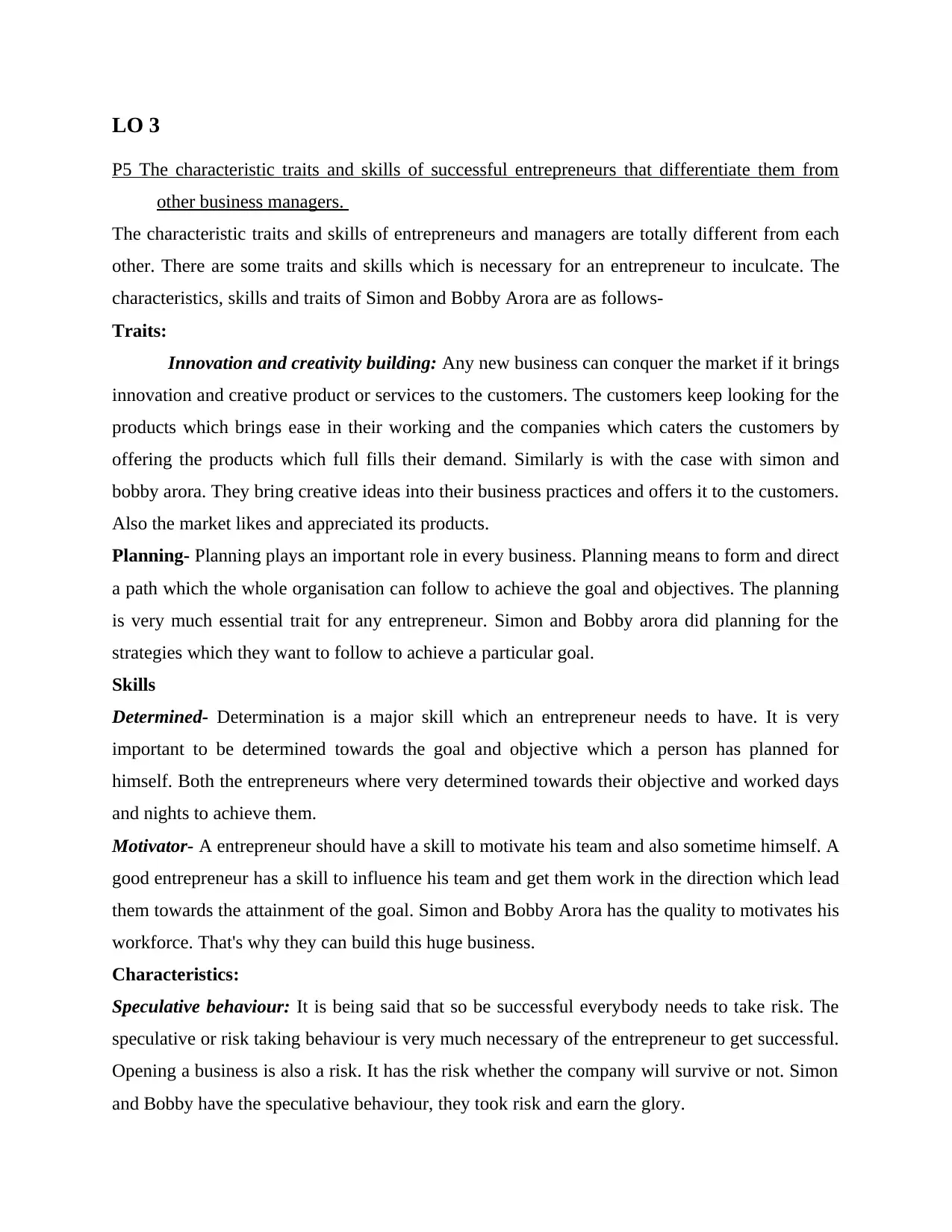
LO 3
P5 The characteristic traits and skills of successful entrepreneurs that differentiate them from
other business managers.
The characteristic traits and skills of entrepreneurs and managers are totally different from each
other. There are some traits and skills which is necessary for an entrepreneur to inculcate. The
characteristics, skills and traits of Simon and Bobby Arora are as follows-
Traits:
Innovation and creativity building: Any new business can conquer the market if it brings
innovation and creative product or services to the customers. The customers keep looking for the
products which brings ease in their working and the companies which caters the customers by
offering the products which full fills their demand. Similarly is with the case with simon and
bobby arora. They bring creative ideas into their business practices and offers it to the customers.
Also the market likes and appreciated its products.
Planning- Planning plays an important role in every business. Planning means to form and direct
a path which the whole organisation can follow to achieve the goal and objectives. The planning
is very much essential trait for any entrepreneur. Simon and Bobby arora did planning for the
strategies which they want to follow to achieve a particular goal.
Skills
Determined- Determination is a major skill which an entrepreneur needs to have. It is very
important to be determined towards the goal and objective which a person has planned for
himself. Both the entrepreneurs where very determined towards their objective and worked days
and nights to achieve them.
Motivator- A entrepreneur should have a skill to motivate his team and also sometime himself. A
good entrepreneur has a skill to influence his team and get them work in the direction which lead
them towards the attainment of the goal. Simon and Bobby Arora has the quality to motivates his
workforce. That's why they can build this huge business.
Characteristics:
Speculative behaviour: It is being said that so be successful everybody needs to take risk. The
speculative or risk taking behaviour is very much necessary of the entrepreneur to get successful.
Opening a business is also a risk. It has the risk whether the company will survive or not. Simon
and Bobby have the speculative behaviour, they took risk and earn the glory.
P5 The characteristic traits and skills of successful entrepreneurs that differentiate them from
other business managers.
The characteristic traits and skills of entrepreneurs and managers are totally different from each
other. There are some traits and skills which is necessary for an entrepreneur to inculcate. The
characteristics, skills and traits of Simon and Bobby Arora are as follows-
Traits:
Innovation and creativity building: Any new business can conquer the market if it brings
innovation and creative product or services to the customers. The customers keep looking for the
products which brings ease in their working and the companies which caters the customers by
offering the products which full fills their demand. Similarly is with the case with simon and
bobby arora. They bring creative ideas into their business practices and offers it to the customers.
Also the market likes and appreciated its products.
Planning- Planning plays an important role in every business. Planning means to form and direct
a path which the whole organisation can follow to achieve the goal and objectives. The planning
is very much essential trait for any entrepreneur. Simon and Bobby arora did planning for the
strategies which they want to follow to achieve a particular goal.
Skills
Determined- Determination is a major skill which an entrepreneur needs to have. It is very
important to be determined towards the goal and objective which a person has planned for
himself. Both the entrepreneurs where very determined towards their objective and worked days
and nights to achieve them.
Motivator- A entrepreneur should have a skill to motivate his team and also sometime himself. A
good entrepreneur has a skill to influence his team and get them work in the direction which lead
them towards the attainment of the goal. Simon and Bobby Arora has the quality to motivates his
workforce. That's why they can build this huge business.
Characteristics:
Speculative behaviour: It is being said that so be successful everybody needs to take risk. The
speculative or risk taking behaviour is very much necessary of the entrepreneur to get successful.
Opening a business is also a risk. It has the risk whether the company will survive or not. Simon
and Bobby have the speculative behaviour, they took risk and earn the glory.
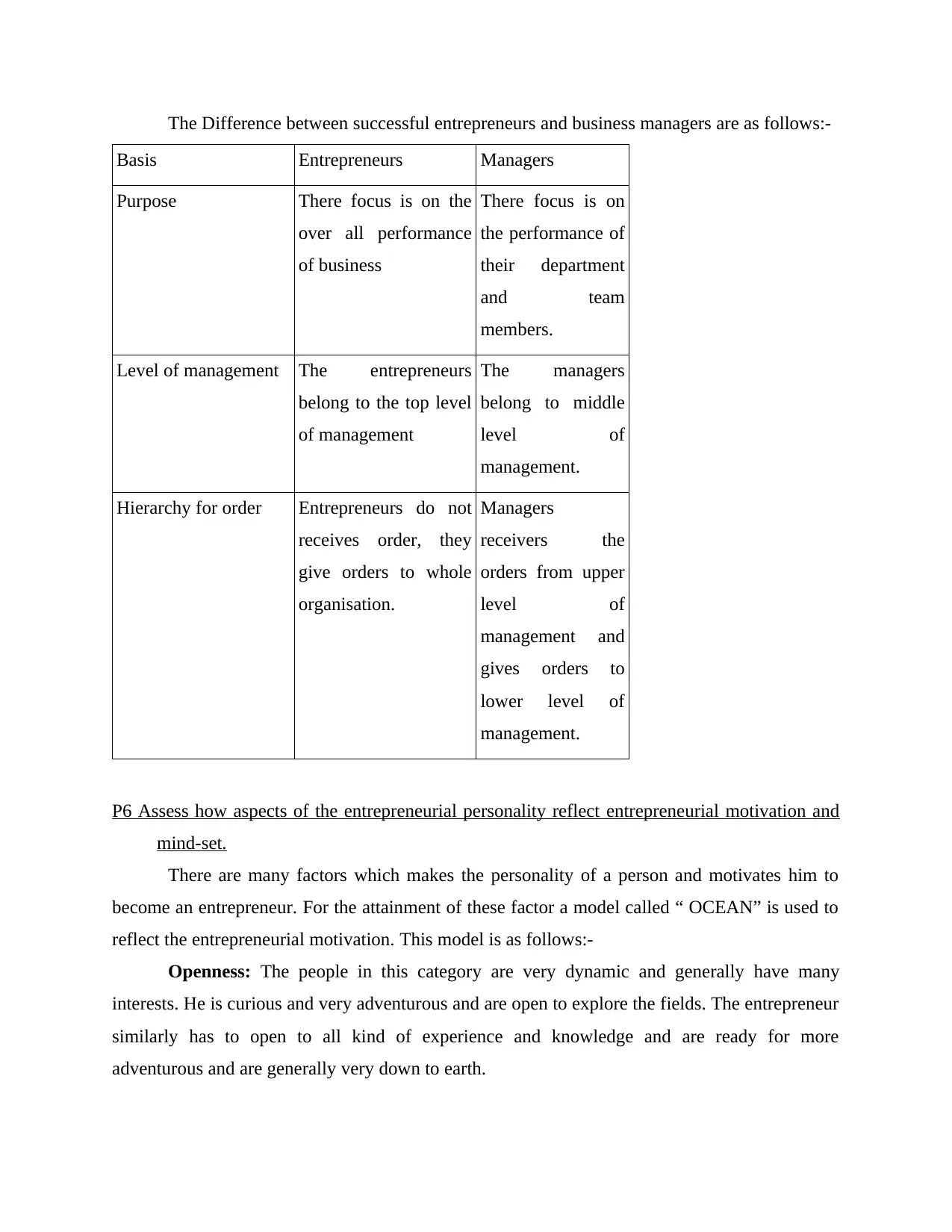
The Difference between successful entrepreneurs and business managers are as follows:-
Basis Entrepreneurs Managers
Purpose There focus is on the
over all performance
of business
There focus is on
the performance of
their department
and team
members.
Level of management The entrepreneurs
belong to the top level
of management
The managers
belong to middle
level of
management.
Hierarchy for order Entrepreneurs do not
receives order, they
give orders to whole
organisation.
Managers
receivers the
orders from upper
level of
management and
gives orders to
lower level of
management.
P6 Assess how aspects of the entrepreneurial personality reflect entrepreneurial motivation and
mind-set.
There are many factors which makes the personality of a person and motivates him to
become an entrepreneur. For the attainment of these factor a model called “ OCEAN” is used to
reflect the entrepreneurial motivation. This model is as follows:-
Openness: The people in this category are very dynamic and generally have many
interests. He is curious and very adventurous and are open to explore the fields. The entrepreneur
similarly has to open to all kind of experience and knowledge and are ready for more
adventurous and are generally very down to earth.
Basis Entrepreneurs Managers
Purpose There focus is on the
over all performance
of business
There focus is on
the performance of
their department
and team
members.
Level of management The entrepreneurs
belong to the top level
of management
The managers
belong to middle
level of
management.
Hierarchy for order Entrepreneurs do not
receives order, they
give orders to whole
organisation.
Managers
receivers the
orders from upper
level of
management and
gives orders to
lower level of
management.
P6 Assess how aspects of the entrepreneurial personality reflect entrepreneurial motivation and
mind-set.
There are many factors which makes the personality of a person and motivates him to
become an entrepreneur. For the attainment of these factor a model called “ OCEAN” is used to
reflect the entrepreneurial motivation. This model is as follows:-
Openness: The people in this category are very dynamic and generally have many
interests. He is curious and very adventurous and are open to explore the fields. The entrepreneur
similarly has to open to all kind of experience and knowledge and are ready for more
adventurous and are generally very down to earth.
Secure Best Marks with AI Grader
Need help grading? Try our AI Grader for instant feedback on your assignments.

Conscientiousness: This type of entrepreneurs are highly determined and goal oriented
people. They have control and high thoughtfulness. These people are disciplined and planned
everything regarding their agenda which they follows. Entrepreneurs are very determined to the
goal to survive their enterprises and towards its growth.
Extraversion: these type of people are very extrovert and easily expresses their emotions
to others. These people are very talkative and highly energetic. Personality like this is easily
visible to others and they happen to be great leaders as well. Being in social surroundings and
situations gives them more courage to go for their business (Tang, Kacmar and Busenitz, 2012).
Agreeableness: It is said that they are the best people to meet with. They are empathic, kind,
affectionate, generous and very helpful. These people understands the situations and agree with
the other people if they think they are right. Also such people have a keen interest into the lives
of others. Entrepreneurs like this attract the people which increases the influencers. People get
attracted to them and tend to follow their path.
Neuroticism: These people are quite unstable and unhappy. Such people can get irritate very
easily and experience anxiety very often. Entrepreneurs with this trait cannot make their
workforce motivated and happy as he him selves suffers from anxieties.
LO 4
P7 Examine, using relevant examples, how background and experience can hinder or foster
entrepreneurship.
The background, education, surroundings, past experience, family and friends and so
forth does forms the mind- set of a person in becoming an entrepreneur. All these factors builds
up the personality, skills and traits of an entrepreneur. For example-
J.K. Rowling: J.K. Rowling is an author, producer, writer and a philanthropist. She did
her BA in English literature from a well known institute. Besides facing many problems and
issues in her personal life like divorce, single parenthood, re marriage, she did not bury her
dream to become a writer (Yamakawa, Peng, and Deeds, 2015). She was determined for the
passion of he to write. She is the author of the most famous book “ harry potter and the sagas”
which was a epic work of the time. In this her determination, passion and her creativity to write
plays a major role in becoming this famous and influential. She also named as “ the most
influential woman in Britain” by a leading magazine.
people. They have control and high thoughtfulness. These people are disciplined and planned
everything regarding their agenda which they follows. Entrepreneurs are very determined to the
goal to survive their enterprises and towards its growth.
Extraversion: these type of people are very extrovert and easily expresses their emotions
to others. These people are very talkative and highly energetic. Personality like this is easily
visible to others and they happen to be great leaders as well. Being in social surroundings and
situations gives them more courage to go for their business (Tang, Kacmar and Busenitz, 2012).
Agreeableness: It is said that they are the best people to meet with. They are empathic, kind,
affectionate, generous and very helpful. These people understands the situations and agree with
the other people if they think they are right. Also such people have a keen interest into the lives
of others. Entrepreneurs like this attract the people which increases the influencers. People get
attracted to them and tend to follow their path.
Neuroticism: These people are quite unstable and unhappy. Such people can get irritate very
easily and experience anxiety very often. Entrepreneurs with this trait cannot make their
workforce motivated and happy as he him selves suffers from anxieties.
LO 4
P7 Examine, using relevant examples, how background and experience can hinder or foster
entrepreneurship.
The background, education, surroundings, past experience, family and friends and so
forth does forms the mind- set of a person in becoming an entrepreneur. All these factors builds
up the personality, skills and traits of an entrepreneur. For example-
J.K. Rowling: J.K. Rowling is an author, producer, writer and a philanthropist. She did
her BA in English literature from a well known institute. Besides facing many problems and
issues in her personal life like divorce, single parenthood, re marriage, she did not bury her
dream to become a writer (Yamakawa, Peng, and Deeds, 2015). She was determined for the
passion of he to write. She is the author of the most famous book “ harry potter and the sagas”
which was a epic work of the time. In this her determination, passion and her creativity to write
plays a major role in becoming this famous and influential. She also named as “ the most
influential woman in Britain” by a leading magazine.
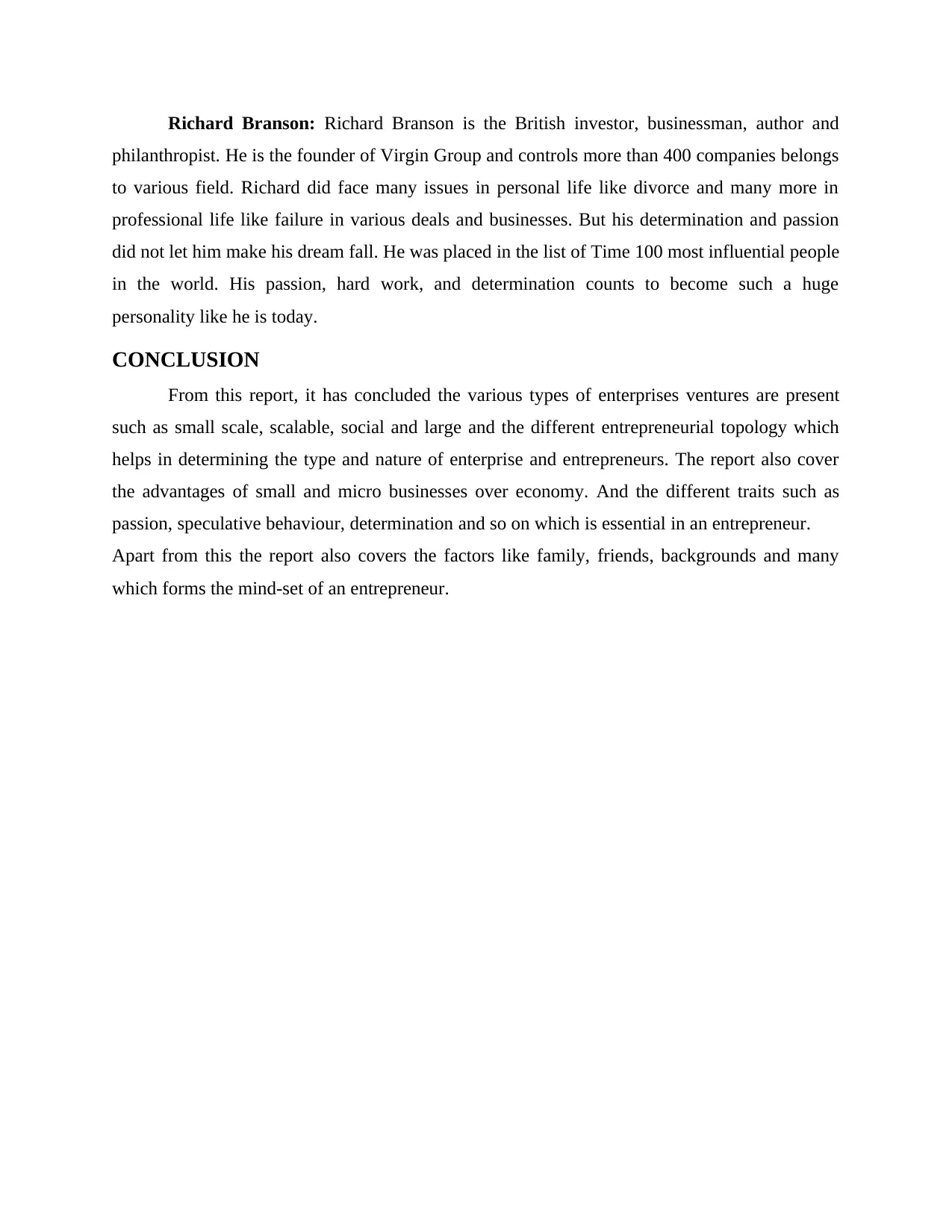
Richard Branson: Richard Branson is the British investor, businessman, author and
philanthropist. He is the founder of Virgin Group and controls more than 400 companies belongs
to various field. Richard did face many issues in personal life like divorce and many more in
professional life like failure in various deals and businesses. But his determination and passion
did not let him make his dream fall. He was placed in the list of Time 100 most influential people
in the world. His passion, hard work, and determination counts to become such a huge
personality like he is today.
CONCLUSION
From this report, it has concluded the various types of enterprises ventures are present
such as small scale, scalable, social and large and the different entrepreneurial topology which
helps in determining the type and nature of enterprise and entrepreneurs. The report also cover
the advantages of small and micro businesses over economy. And the different traits such as
passion, speculative behaviour, determination and so on which is essential in an entrepreneur.
Apart from this the report also covers the factors like family, friends, backgrounds and many
which forms the mind-set of an entrepreneur.
philanthropist. He is the founder of Virgin Group and controls more than 400 companies belongs
to various field. Richard did face many issues in personal life like divorce and many more in
professional life like failure in various deals and businesses. But his determination and passion
did not let him make his dream fall. He was placed in the list of Time 100 most influential people
in the world. His passion, hard work, and determination counts to become such a huge
personality like he is today.
CONCLUSION
From this report, it has concluded the various types of enterprises ventures are present
such as small scale, scalable, social and large and the different entrepreneurial topology which
helps in determining the type and nature of enterprise and entrepreneurs. The report also cover
the advantages of small and micro businesses over economy. And the different traits such as
passion, speculative behaviour, determination and so on which is essential in an entrepreneur.
Apart from this the report also covers the factors like family, friends, backgrounds and many
which forms the mind-set of an entrepreneur.
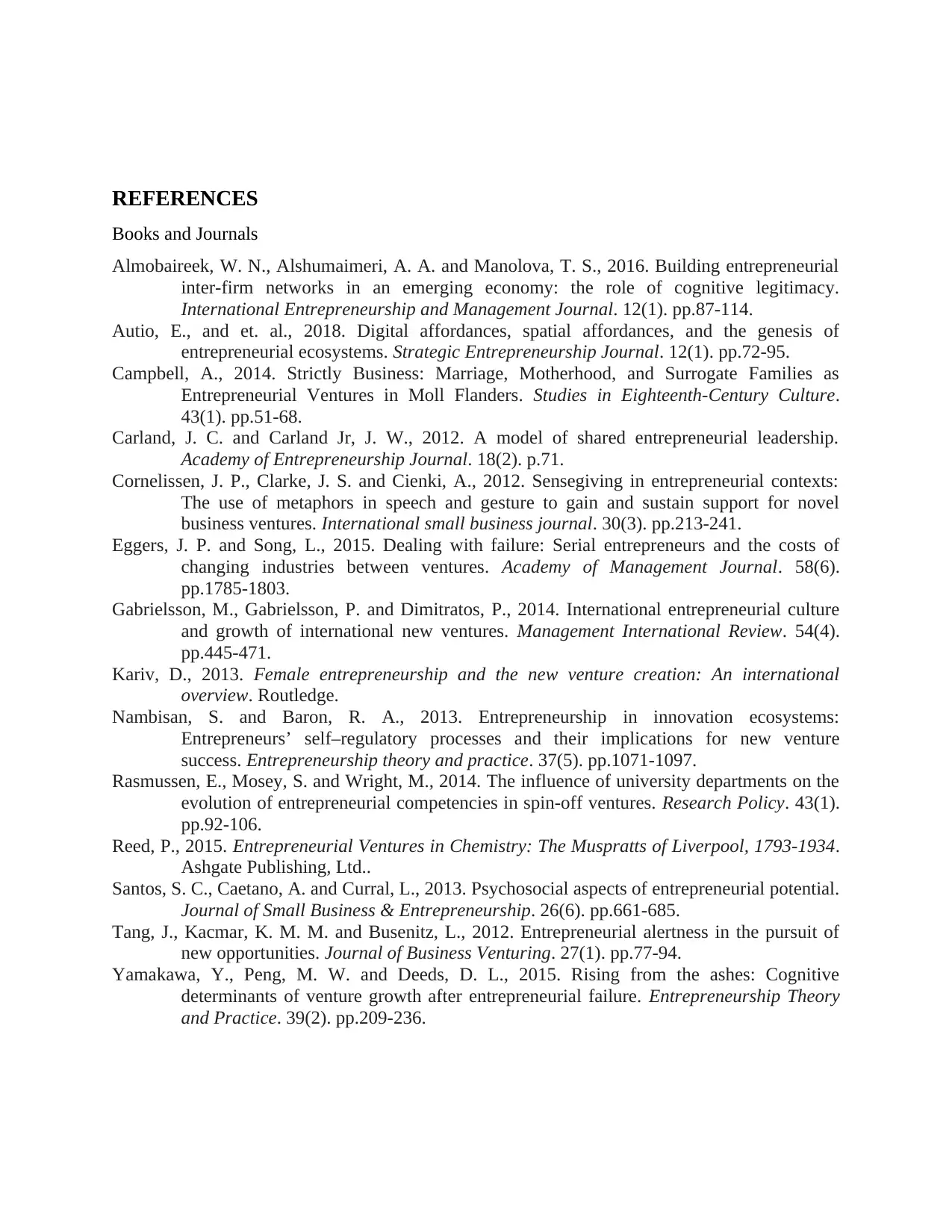
REFERENCES
Books and Journals
Almobaireek, W. N., Alshumaimeri, A. A. and Manolova, T. S., 2016. Building entrepreneurial
inter-firm networks in an emerging economy: the role of cognitive legitimacy.
International Entrepreneurship and Management Journal. 12(1). pp.87-114.
Autio, E., and et. al., 2018. Digital affordances, spatial affordances, and the genesis of
entrepreneurial ecosystems. Strategic Entrepreneurship Journal. 12(1). pp.72-95.
Campbell, A., 2014. Strictly Business: Marriage, Motherhood, and Surrogate Families as
Entrepreneurial Ventures in Moll Flanders. Studies in Eighteenth-Century Culture.
43(1). pp.51-68.
Carland, J. C. and Carland Jr, J. W., 2012. A model of shared entrepreneurial leadership.
Academy of Entrepreneurship Journal. 18(2). p.71.
Cornelissen, J. P., Clarke, J. S. and Cienki, A., 2012. Sensegiving in entrepreneurial contexts:
The use of metaphors in speech and gesture to gain and sustain support for novel
business ventures. International small business journal. 30(3). pp.213-241.
Eggers, J. P. and Song, L., 2015. Dealing with failure: Serial entrepreneurs and the costs of
changing industries between ventures. Academy of Management Journal. 58(6).
pp.1785-1803.
Gabrielsson, M., Gabrielsson, P. and Dimitratos, P., 2014. International entrepreneurial culture
and growth of international new ventures. Management International Review. 54(4).
pp.445-471.
Kariv, D., 2013. Female entrepreneurship and the new venture creation: An international
overview. Routledge.
Nambisan, S. and Baron, R. A., 2013. Entrepreneurship in innovation ecosystems:
Entrepreneurs’ self–regulatory processes and their implications for new venture
success. Entrepreneurship theory and practice. 37(5). pp.1071-1097.
Rasmussen, E., Mosey, S. and Wright, M., 2014. The influence of university departments on the
evolution of entrepreneurial competencies in spin-off ventures. Research Policy. 43(1).
pp.92-106.
Reed, P., 2015. Entrepreneurial Ventures in Chemistry: The Muspratts of Liverpool, 1793-1934.
Ashgate Publishing, Ltd..
Santos, S. C., Caetano, A. and Curral, L., 2013. Psychosocial aspects of entrepreneurial potential.
Journal of Small Business & Entrepreneurship. 26(6). pp.661-685.
Tang, J., Kacmar, K. M. M. and Busenitz, L., 2012. Entrepreneurial alertness in the pursuit of
new opportunities. Journal of Business Venturing. 27(1). pp.77-94.
Yamakawa, Y., Peng, M. W. and Deeds, D. L., 2015. Rising from the ashes: Cognitive
determinants of venture growth after entrepreneurial failure. Entrepreneurship Theory
and Practice. 39(2). pp.209-236.
Books and Journals
Almobaireek, W. N., Alshumaimeri, A. A. and Manolova, T. S., 2016. Building entrepreneurial
inter-firm networks in an emerging economy: the role of cognitive legitimacy.
International Entrepreneurship and Management Journal. 12(1). pp.87-114.
Autio, E., and et. al., 2018. Digital affordances, spatial affordances, and the genesis of
entrepreneurial ecosystems. Strategic Entrepreneurship Journal. 12(1). pp.72-95.
Campbell, A., 2014. Strictly Business: Marriage, Motherhood, and Surrogate Families as
Entrepreneurial Ventures in Moll Flanders. Studies in Eighteenth-Century Culture.
43(1). pp.51-68.
Carland, J. C. and Carland Jr, J. W., 2012. A model of shared entrepreneurial leadership.
Academy of Entrepreneurship Journal. 18(2). p.71.
Cornelissen, J. P., Clarke, J. S. and Cienki, A., 2012. Sensegiving in entrepreneurial contexts:
The use of metaphors in speech and gesture to gain and sustain support for novel
business ventures. International small business journal. 30(3). pp.213-241.
Eggers, J. P. and Song, L., 2015. Dealing with failure: Serial entrepreneurs and the costs of
changing industries between ventures. Academy of Management Journal. 58(6).
pp.1785-1803.
Gabrielsson, M., Gabrielsson, P. and Dimitratos, P., 2014. International entrepreneurial culture
and growth of international new ventures. Management International Review. 54(4).
pp.445-471.
Kariv, D., 2013. Female entrepreneurship and the new venture creation: An international
overview. Routledge.
Nambisan, S. and Baron, R. A., 2013. Entrepreneurship in innovation ecosystems:
Entrepreneurs’ self–regulatory processes and their implications for new venture
success. Entrepreneurship theory and practice. 37(5). pp.1071-1097.
Rasmussen, E., Mosey, S. and Wright, M., 2014. The influence of university departments on the
evolution of entrepreneurial competencies in spin-off ventures. Research Policy. 43(1).
pp.92-106.
Reed, P., 2015. Entrepreneurial Ventures in Chemistry: The Muspratts of Liverpool, 1793-1934.
Ashgate Publishing, Ltd..
Santos, S. C., Caetano, A. and Curral, L., 2013. Psychosocial aspects of entrepreneurial potential.
Journal of Small Business & Entrepreneurship. 26(6). pp.661-685.
Tang, J., Kacmar, K. M. M. and Busenitz, L., 2012. Entrepreneurial alertness in the pursuit of
new opportunities. Journal of Business Venturing. 27(1). pp.77-94.
Yamakawa, Y., Peng, M. W. and Deeds, D. L., 2015. Rising from the ashes: Cognitive
determinants of venture growth after entrepreneurial failure. Entrepreneurship Theory
and Practice. 39(2). pp.209-236.
Paraphrase This Document
Need a fresh take? Get an instant paraphrase of this document with our AI Paraphraser

1 out of 14
Related Documents
Your All-in-One AI-Powered Toolkit for Academic Success.
+13062052269
info@desklib.com
Available 24*7 on WhatsApp / Email
![[object Object]](/_next/static/media/star-bottom.7253800d.svg)
Unlock your academic potential
© 2024 | Zucol Services PVT LTD | All rights reserved.




